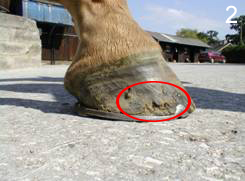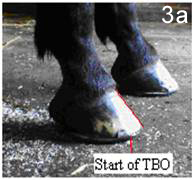The RockFoot Concept
Introduction
As a Referral Farrier most of my work is with horses that have had some kind of previous hoof treatment that has not been successful. When working with my clients I adopt the NCT rule, Nutrition, Condition then Trimming.
Barefoot is not about taking the shoes off and letting nature do her thing.
All domestic horses must compromise; shod horses more than barefoot ones.
The shod horse will often have external references that show the compromises made.
Take the external wall of the hoof.
The dorsal wall angle (DWA) at the point of horn production
At the point of production the dorsal wall will try and stay parallel with the pedal bone (p3) for as long as it can even in times of great stress!


The stress on all parts of this foot are reflected in the angle of horn production and quality of the wall
If the DWA is sympathetic to P3 around the whole wall there is less stress on the dorsal and terminal laminae in the shod hoof as in Fig: 3a & 3b or barefoot Fig 4


Or barefoot: Fig: 4

Caudal third strength will also help in assessing the compromises that have been made:
How long are the heels, how supportive are the bars, how healthy and supportive is the frog tissue, how large and dense is the digital cushion.
All these can be observed from the outside. See Figs 7-8.


By assessing the sole tissue at the seat of corn it is possible to see how much heel and bar tissue MIGHT be removed, and how much controlled concussion the frog, digital cushion and bars need depending on work and conditions Fig 9.

This horse had been shod 6 days before this picture was taken; the frog, digital cushion and bars are not going to have any contact with the ground, hence the reason for the tissue being soft, split and useless.


Fig 10. A foot going through transition before trimming
Fig 11. Healthy self trimmed heel of hard working endurance horse.
Getting both reference points wrong!
Angles Length
Length
Fig:12 Referred to me because the horse could not stay sound - ‘No, really?’
Fig:13 This pony was starting to find
walking difficult!

"Each horse is an individual - each foot is individual to that horse"
There are as many ways to trim a barefoot as there are people doing it! I have no intention of saying one way is better than another or that there is the perfect way. But I will say this to anyone going near a horse’s foot with any tool that can remove tissue. Look, think; learn from the horse’s foot before you remove anything. Do you know why a foot is the way it is, what is the foot telling you? If you can not answer those two questions then put the foot down, stand back and think again. You will not regret any time that you spend trying to understand and learn the language of the hoof.
Although the reference points that I need are on the outside, an understanding of anatomy is crucial when assessing a hoof before trimming.
You must know where, why and how tissue is being produced before you inflict an effect on the new growth. For example:
- If extra sole tissue is prevalent around the point of the frog, where has it come from, why is it there?
- What is attached to the weight bearing areas of the hoof that are affected by trimming?
- What lies beneath the frog that enables it to produce a different type of tissue from its surrounding parts and why?
This knowledge means that you can start to read the foot better from the outside
I do not believe in the concept of a pre-determined trimming or shoeing method that can apply to every horse’s foot.
Successful trimming means having to do less!
There are many learned people researching into barefoot, from herds of horses in Australia, and the USA, to rehabilitation centres here in the UK. Yet I can’t help thinking that if the same effort was going into the effect of shoeing upon horses, then we would start to look less at treating ailments and more at not creating them! I firmly believe that a horse has the ability to produce feet that can deal with the environment it will be living and working in. In my own practise the work I do with Dartmoor ponies has helped me realise that all horses have to be managed if they are not in the right environment.
In my professional career I have been very lucky to have met some amazing people who have inspired and encouraged me, far too many to name them all, but I would like to single out one or two:
William Watts, Ian Washbrook, Richard Parsons, Trevor Whitbread, Chris Pollitt, Rick Redden
I have found the World Wide Web an amazing source of information on barefoot and equine nutrition and I would recommend any of the following:
Jamie Jackson, Pete Ramey, Clare Mc Cloud, Chris Pollitt, Joe Camp, Robert Bowker, Nic Barker, Cole Henderson, Clare MacLeod
Insulin resistance: http://www.balancedequinenutrition.com/IRArticle.html
But I have learnt much, much more from the horses I have treated, so to all of them I say,
Thank you